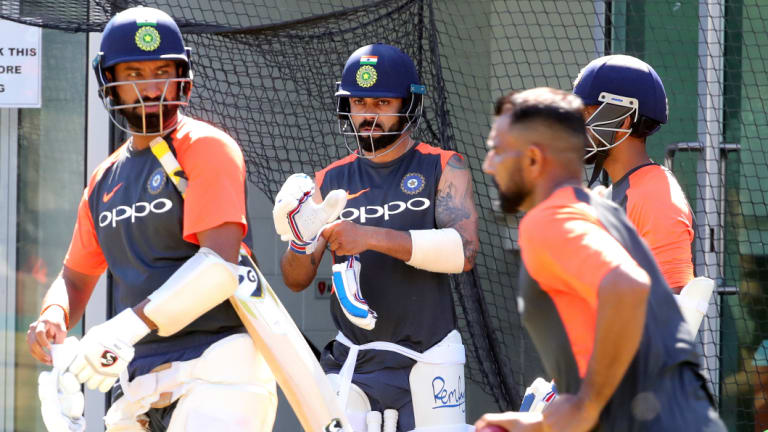Good old siege mentality signals it’s time for real India to stand up

The day after the second Test match in Perth, The Hindu newspaper had picked up the biased-local-media conspiracy theory and was running hard and straight with it. Citing the scrutiny of Ishant Sharmas front foot and Virat Kohlis eyebrow acting, the video footage of Sharma and Ravindra Jadeja arguing at Perth Stadium, and even the broadcast of a 10th anniversary documentary of the Monkeygate controversy, the respected Indian outlet spoke of an Australian tendency to "dig dirt, especially pertaining to the visiting team".

Circling the wagons? Virat Kohli (centre) prepares to bat in the MCG nets. Credit:AAP
Insofar as this reflects attitudes within the touring party, it usually means one of two things. Either a siege mentality has taken over, threatening to drag down the Indian team as it has done touring teams of all nations in all parts of the world all too often; or a siege mentality is being confected to bring the Indian team tighter and motivate them against a sense of injustice. Paranoia can work both ways, but on cricket tours it usually turns up sooner or later.
Whether real or not, the intervention of the faithful old siege mentality points to a big question that has arisen in Adelaide and Perth, which is around the Indian teams motivation. A far more accomplished and experienced unit than Australia, Kohlis batsmen have performed below their best in both matches. Against an honest if not elite Australian team, India did just enough to win in Adelaide, while in Perth they lacked luck and fight, in that sequence. As an Indian-born friend put it to me: "The difference is that 11 Australians really want to win, and only one Indian wants to win as much." Or, put another way: India want to win, but Australia need to win.
Advertisement
Kohlis desire to win is conspicuous to be often mistaken for a form of madness. His teammates cannot live up to either the performance or the intensity, but that doesnt mean they dont want to win as much as he does. There is, nonetheless, an anxiety within the Indian public that Australians would recognise: a belief that the players live in a gilded bubble; that, as members of the Twenty20 generation, they lack the sense of history that should drive them beyond normal limits to be the first Indian team to win a Test series in Australia; that their will has been softened by the easy riches flowing out of the Indian Premier League; that they fail to see themselves as custodians of a cap that represents a whole country. Such criticisms come out of defeat and are used to explain it, regardless of accuracy. Its often more a statement of what the public has decided to believe.
The Australians, by contrast, post-purge, have a simple and unifying motivation: they dont want to be the first team to lose to India in Australia, and they have a great desire to show that they can win without Steve Smith and David Warner. In an oblique way, the absence of those two plus Cameron Bancroft has done the remaining players a favour.

Combustible Kohli: The Australia and India captains engage in some on-field niceties in Perth. Credit:AAP
With the series arriving in Melbourne at one-all, this is the time for the Indians to show if they are an authentic world No.1 team or not. To be a true champion cricket team, they must win away from home. You would think that is motivation enough.
One thing The Hindu got absolutely right is that the current series has been so enthralling that it deserves not to be fuzzed over by peripheral matters. Are sections of the Australian media trying to get under Indian skins? Only if it helps attract eyeballs, but there is no need for a conspiracy, and nor are Australians well-organised enough to orchestrate one. Far from being selectively leaked, the Sharma-Jadeja footage was belatedly found and then broadcast universally. In fact, the embedded correspondent sitting next to me saw it happen live as it went on, all 90 seconds of it, thought nothing of it, and went on dreaming up rhapsodies about Kohlis earlier century.
What all sides can agree on is that some wonderful cricket gets too easily overshadowed by the easier-to-understand soap opera elements. I thought Kohlis first-innings century in Perth was so good, in the circumstances and on that wicket, that if hed gone on for another hour and made it a match-winner, it would have been knocking on the door of the small cubicle reserved for the best three innings I have ever had the privilege to see in the flesh (for the record, Brian Lara Bridgetown 1999, Brian Lara Kingston 1999, and Mark Waugh Port Elizabeth 1997). But in a twinkling, the world had forgotten the dazzling skill of Kohlis batting and was talking about the video reviews of his dismissal and then his facial expressions in the field.
Such is the world. But the underlying drama carries more power and lasts longer than the evanescent video skirmishes. We have seen 10 days of cricket in which neither team has remained on top for more than an hour at a time. It is a more even, fluctuating, unpredictable cricket contest than has been seen in Australia for many years. With a series to be won in Melbourne and Sydney, the temperature can scarcely fail to rise further. The tightness of the cricket is the best indicator of how motivated both of these teams are. We are about to find out who really does have the greater need.
Malcolm Knox is a sports columnist for The Sydney Morning Herald.
Most Viewed in Sport
[contf] [contfnew] 
Australian Breaking News Headlines
[contfnewc] [contfnewc]




